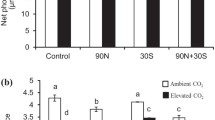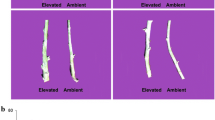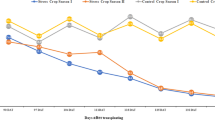Abstract
Recently, there has been growing concern over the potential impact of CO2 concentration and temperature on herbicide efficacy. The aim of the study was to examine the influence of single elevated CO2 (400 vs. 800 ppm) and elevated CO2 in combination with temperature (21 °C vs. 25 °C) on the effects of auxin herbicide 4-chloro-2-methylphenoxyacetic acid (MCPA) (0.5–2 × field recommended rate) to wild mustard (Sinapis arvensis L.) grown in mixed-culture with spring barley (Hordeum vulgare L.). MCPA had a detrimental effect on aboveground and belowground biomass, content of chlorophylls, enzymatic and non-enzymatic antioxidants and induced oxidative stress. The significant decline in photosynthetic rate, stomatal conductance and transpiration with MCPA dose was detected. Elevated CO2 reinforced MCPA efficacy on S. arvensis: sharper decline in biomass, photosynthetic rate and antioxidant enzymes and more pronounced lipid peroxidation were detected. Under elevated CO2 and temperature, MCPA efficacy to control S. arvensis dropped due to herbicide dilution because of increased root:shoot ratio, higher activity of antioxidants and less pronounced oxidative damage. Reinforced MCPA impact on weeds under elevated CO2 resulted in higher H. vulgare biomass, while decreased MCPA efficacy under elevated CO2 and temperature reduced H. vulgare biomass.







Similar content being viewed by others
Data availability
The datasets used and/or analysed during the current study are available from the corresponding author on reasonable request.
References
Aebi H (1984) Catalase in Vitro. Methods Enzymol. https://doi.org/10.1016/S0076-6879(84)05016-3
Ainsworth EA, Davey PA, Bernacchi CJ et al (2002) A meta-analysis of elevated [CO2] effects on soybean (Glycine max) physiology, growth and yield. Glob Chang Biol 8:695–709. https://doi.org/10.1046/j.1365-2486.2002.00498.x
Ainsworth EA, Rogers A (2007) The response of photosynthesis and stomatal conductance to rising [CO2]: mechanisms and environmental interactions. Plant Cell Environ 30:258–270. https://doi.org/10.1111/j.1365-3040.2007.01641.x
Archambault DJ, Li X, Robinson D et al (2001) The effects of elevated CO2 and temperature on herbicide efficacy and weed/crop competition. Report to the Prairie Adaptation Research Collaborative No 29
Bailey SW (2004) Climate change and decreasing herbicide persistence. Pest Manag Sci 60:158–162. https://doi.org/10.1002/ps.785
Baillard V, Sulmon C, Bittebiere A-K et al (2020) Effect of interspecific competition on species sensitivity distribution models: analysis of plant responses to chemical stress. Ecotoxicol Environ Saf 200:110722. https://doi.org/10.1016/j.ecoenv.2020.110722
Bajwa AA, Wang H, Chauhan BS, Adkins SW (2019) Effect of elevated carbon dioxide concentration on growth, productivity and glyphosate response of parthenium weed (Parthenium hysterophorus L.). Pest Manag Sci 75:2934–2941. https://doi.org/10.1002/ps.5403
Benzie IFF, Strain JJ (1996) The ferric reducing ability of plasma (FRAP) as a measure of “antioxidant power”: the FRAP assay. Anal Biochem 239:70–76. https://doi.org/10.1006/abio.1996.0292
Boutin C, Montroy K, Mathiassen SK et al (2019) Effects of sublethal doses of herbicides on the competitive interactions between 2 nontarget plants, Centaurea cyanus L. and Silene noctiflora L. Environ Toxicol Chem 38:2053–2064. https://doi.org/10.1002/etc.4506
Busi R, Goggin DE, Heap IM et al (2018) Weed resistance to synthetic auxin herbicides. Pest Manag Sci 74:2265–2276. https://doi.org/10.1002/ps.4823
Caliandro R, Nagel KA, Kastenholz B et al (2013) Effects of altered α - and β -branch carotenoid biosynthesis on photoprotection and whole-plant acclimation of Arabidopsis to photo-oxidative stress. Plant Cell Environ 36:438–453. https://doi.org/10.1111/j.1365-3040.2012.02586.x
Clausen SK, Frenck G, Linden LG et al (2011) Effects of single and multifactor treatments with elevated temperature, CO2 and ozone on oilseed rape and barley. J Agron Crop Sci 197:442–453. https://doi.org/10.1111/j.1439-037X.2011.00478.x
Cowie BW, Venter N, Witkowski ETF, Byrne MJ (2020) Implications of elevated carbon dioxide on the susceptibility of the globally invasive weed, Parthenium hysterophorus, to glyphosate herbicide. Pest Manag Sci 76:2324–2332. https://doi.org/10.1002/ps.5767
Damgaard C, Mathiassen SK, Kudsk P (2008) Modeling effects of herbicide drift on the competitive interactions between weeds. Environ Toxicol Chem 27:1302. https://doi.org/10.1897/07-267.1
Damgaard C, Strandberg B, Mathiassen SK, Kudsk P (2014) The effect of glyphosate on the growth and competitive effect of perennial grass species in semi-natural grasslands. J Environ Sci Heal Part B 49:897–908. https://doi.org/10.1080/03601234.2014.951571
Delcour I, Spanoghe P, Uyttendaele M (2015) Literature review: impact of climate change on pesticide use. Food Res Int 68:7–15. https://doi.org/10.1016/j.foodres.2014.09.030
Deutsch CA, Tewksbury JJ, Tigchelaar M et al (2018) Increase in crop losses to insect pests in a warming climate. Science 361(80):916–919. https://doi.org/10.1126/science.aat3466
Dhima K, Eleftherohorinos I (2005) Wild mustard (Sinapis arvensis L.) competition with three winter cereals as affected by nitrogen supply. J Agron Crop Sci 191:241–248. https://doi.org/10.1111/j.1439-037X.2005.00152.x
Dhindsa RS, Plumb-Dhindsa P, Thorpe TA (1981) Leaf senescence: correlated with increased levels of membrane permeability and lipid peroxidation, and decreased levels of superoxide dismutase and catalase. J Exp Bot 32:93–101. https://doi.org/10.1093/jxb/32.1.93
Duursma RA, Barton CVM, Eamus D et al (2011) Rooting depth explains [CO2] x drought interaction in Eucalyptus saligna. Tree Physiol 31:922–931. https://doi.org/10.1093/treephys/tpr030
Elferjani R, Soolanayakanahally R (2018) Canola responses to drought, heat, and combined stress: shared and specific effects on carbon assimilation, seed yield, and oil composition. Front Plant Sci 9. https://doi.org/10.3389/fpls.2018.01224
Fantke P, Gillespie BW, Juraske R, Jolliet O (2014) Estimating half-lives for pesticide dissipation from plants. Environ Sci Technol 48:8588–8602. https://doi.org/10.1021/es500434p
Feng G-Q, Li Y, Cheng (Max) Z-M (2014) Plant molecular and genomic responses to stresses in projected future CO2 environment. CRC Crit Rev Plant Sci 33:238–249. https://doi.org/10.1080/07352689.2014.870421
Foyer CH (2018) Reactive oxygen species, oxidative signaling and the regulation of photosynthesis. Environ Exp Bot 154:134–142. https://doi.org/10.1016/j.envexpbot.2018.05.003
Foyer CH, Noctor G (2000) Tansley Review No. 112. Oxygen processing in photosynthesis :regulation and signalling. New Phytol 146:359–388. https://doi.org/10.1046/j.1469-8137.2000.00667.x
Ganie ZA, Jugulam M, Jhala AJ (2017) Temperature influences efficacy, absorption, and translocation of 2,4-D or glyphosate in glyphosate-resistant and glyphosate-susceptible common ragweed (Ambrosia artemisiifolia) and giant ragweed (Ambrosia trifida). Weed Sci 65:588–602. https://doi.org/10.1017/wsc.2017.32
Gianessi LP (2013) The increasing importance of herbicides in worldwide crop production. Pest Manag Sci 69:1099–1105. https://doi.org/10.1002/ps.3598
Giri A, Heckathorn S, Mishra S, Krause C (2017) Heat stress decreases levels of nutrient-uptake and -assimilation proteins in tomato roots. Plants 6:6. https://doi.org/10.3390/plants6010006
Godar AS, Varanasi VK, Nakka S et al (2015) Physiological and molecular mechanisms of differential sensitivity of palmer amaranth (Amaranthus palmeri) to mesotrione at varying growth temperatures. PLoS ONE 10:e0126731. https://doi.org/10.1371/journal.pone.0126731
Grabińska-Sota E, Wiśniowska E, Kalka J (2003) Toxicity of selected synthetic auxines—2,4-D and MCPA derivatives to broad-leaved and cereal plants. Crop Prot 22:355–360. https://doi.org/10.1016/S0261-2194(02)00178-3
Grossmann K (2010) Auxin herbicides: current status of mechanism and mode of action. Pest Manag Sci 66:113–120. https://doi.org/10.1002/ps.1860
Grossmann K (2000) Mode of action of auxin herbicides: a new ending to a long, drawn out story. Trends Plant Sci 5:506–508. https://doi.org/10.1016/S1360-1385(00)01791-X
Grossmann K, Hansen H (2001) Ethylene-triggered abscisic acid: a principle in plant growth regulation? Physiol Plant 113:9–14. https://doi.org/10.1034/j.1399-3054.2001.1130102.x
Grossmann K, Kwiatkowski J, Tresch S (2001) Auxin herbicides induce H2O2 overproduction and tissue damage in cleavers (Galium aparine L.). J Exp Bot 52:1811–1816. https://doi.org/10.1093/jexbot/52.362.1811
Habig WH, Pabst MJ, Jakoby WB (1974) Glutathione S-Transferases. J Biol Chem 249:7130–7139. https://doi.org/10.1016/S0021-9258(19)42083-8
Hansen H, Grossmann K (2000) Auxin-induced ethylene triggers abscisic acid biosynthesis and growth inhibition. Plant Physiol 124:1437–1448. https://doi.org/10.1104/pp.124.3.1437
Health Canada (2010) Guidelines for Canadian drinking water quality guideline: Technical document—2-Methyl-4-chlorophenoxyacetic Acid (MCPA). Water, air and climate change bureau, healthy environments and consumer safety branch, health Canada, Ottawa, Ontario
Hörtensteiner S, Kräutler B (2011) Chlorophyll breakdown in higher plants. Biochim Biophys Acta - Bioenerg 1807:977–988. https://doi.org/10.1016/j.bbabio.2010.12.007
IPCC (2013) Climate Change 2013: the physical science basis. Contribution of Working Group I to the Fifth Assessment Report of the Intergovernmental Panel on Climate Change
Johnson BC, Young BG (2002) Influence of temperature and relative humidity on the foliar activity of mesotrione. Weed Sci. https://doi.org/10.1614/0043-1745(2002)050[0157:iotarh]2.0.co;2
Kacienė G, Dikšaitytė A, Januškaitienė I et al (2017) Different crop and weed performance under single and combined effects of elevated CO2 and temperature. Crop Sci 57:935–944. https://doi.org/10.2135/cropsci2016.07.0598
Kacienė G, Miškelytė D, AbdElgawad H et al (2019) O3 pollution in a future climate increases the competition between summer rape and wild mustard. Plant Physiol Biochem 135:194–205. https://doi.org/10.1016/j.plaphy.2018.11.031
Keršytė D, Rimkus E, Kažys J (2015) Klimato rodiklių scenarijai Lietuvos teritorijoje XXI a. (In Lithuanian) Geol Geogr 1:22–35. https://doi.org/10.6001/geol-geogr.v1i1.3069
Liu Y, Pan X, Li J (2015) A 1961–2010 record of fertilizer use, pesticide application and cereal yields: a review. Agron Sustain Dev 35:83–93. https://doi.org/10.1007/s13593-014-0259-9
Lobell DB, Schlenker W, Costa-Roberts J (2011) Climate trends and global crop production since 1980. Science (80) 333(80):616–620. https://doi.org/10.1126/science.1204531
Manea A, Leishman MR, Downey PO (2011) Exotic C4 grasses have increased tolerance to glyphosate under elevated carbon dioxide. Weed Sci 59:28–36. https://doi.org/10.1614/WS-D-10-00080.1
Matzrafi M (2019) Climate change exacerbates pest damage through reduced pesticide efficacy. Pest Manag Sci 75:9–13. https://doi.org/10.1002/ps.5121
Matzrafi M, Brunharo C, Tehranchian P et al (2019) Increased temperatures and elevated CO2 levels reduce the sensitivity of Conyza canadensis and Chenopodium album to glyphosate. Sci Rep 9:2228. https://doi.org/10.1038/s41598-019-38729-x
Matzrafi M, Seiwert B, Reemtsma T et al (2016) Climate change increases the risk of herbicide-resistant weeds due to enhanced detoxification. Planta 244:1217–1227. https://doi.org/10.1007/s00425-016-2577-4
McCarthy-Suárez I, Gómez M, del Río LA, Palma JM (2011a) Organ-specific effects of the auxin herbicide 2,4-D on the oxidative stress and senescence-related parameters of the stems of pea plants. Acta Physiol Plant 33:2239–2247. https://doi.org/10.1007/s11738-011-0763-3
McCarthy-Suárez I, Gómez M, Río LA, Palma JM (2011b) Role of peroxisomes in the oxidative injury induced by 2,4-dichlorophenoxyacetic acid in leaves of pea plants. Biol Plant 55:485–492. https://doi.org/10.1007/s10535-011-0114-7
McCauley CL, McAdam SAM, Bhide K et al (2020) Transcriptomics in Erigeron canadensis reveals rapid photosynthetic and hormonal responses to auxin herbicide application. J Exp Bot 71:3701–3709. https://doi.org/10.1093/jxb/eraa124
McErlich AF, Boydston RA (2014) Current state of weed management in organic and conventional cropping systems. Automation: The future of weed control in cropping systems. Springer, Dordrecht, pp 11–32
Meier U (2001) Growth stages of mono- and dicotyledonous plants. Federal Biological Research Centre for Agriculture and Forestry, Berlin, p 158
Murschell T, Farmer DK (2019) Real-time measurement of herbicides in the atmosphere: a case study of MCPA and 2,4-D during field application. Toxics 7:40. https://doi.org/10.3390/toxics7030040
Murshed R, Lopez-Lauri F, Keller C et al (2008a) Acclimation to drought stress enhances oxidative stress tolerance in Solanum Lycopersicum L. fruits. Plant Stress 2:145–151
Murshed R, Lopez-Lauri F, Sallanon H (2008b) Microplate quantification of enzymes of the plant ascorbate–glutathione cycle. Anal Biochem 383:320–322. https://doi.org/10.1016/j.ab.2008.07.020
Noctor G, Mhamdi A, Chaouch S et al (2012) Glutathione in plants: an integrated overview. Plant Cell Environ 35:454–484. https://doi.org/10.1111/j.1365-3040.2011.02400.x
Noyes PD, McElwee MK, Miller HD et al (2009) The toxicology of climate change: environmental contaminants in a warming world. Environ Int 35:971–986. https://doi.org/10.1016/j.envint.2009.02.006
Oerke E-C (2006) Crop losses to pests. J Agric Sci 144:31–43. https://doi.org/10.1017/S0021859605005708
Ou J, Stahlman PW, Jugulam M (2018) Reduced absorption of glyphosate and decreased translocation of dicamba contribute to poor control of kochia (Kochia scoparia) at high temperature. Pest Manag Sci 74:1134–1142. https://doi.org/10.1002/ps.4463
Pazmiño DM, Rodríguez-Serrano M, Romero-Puertas MC et al (2011) Differential response of young and adult leaves to herbicide 2,4-dichlorophenoxyacetic acid in pea plants: role of reactive oxygen species. Plant Cell Environ 34:1874–1889. https://doi.org/10.1111/j.1365-3040.2011.02383.x
Peña D, López-Piñeiro A, Albarrán Á et al (2015) Environmental fate of the herbicide MCPA in agricultural soils amended with fresh and aged de-oiled two-phase olive mill waste. Environ Sci Pollut Res 22:13915–13925. https://doi.org/10.1007/s11356-015-4622-4
Peters K, Breitsameter L, Gerowitt B (2014) Impact of climate change on weeds in agriculture: a review. Agron Sustain Dev 34:707–721. https://doi.org/10.1007/s13593-014-0245-2
Polit JT, Praczyk T, Pernak J et al (2014) Inhibition of germination and early growth of rape seed (Brassica napus L.) by MCPA in anionic and ester form. Acta Physiol Plant 36:699–711. https://doi.org/10.1007/s11738-013-1448-x
Ramesh K, Matloob A, Aslam F et al (2017) Weeds in a changing climate: vulnerabilities, consequences, and implications for future weed management. Front Plant Sci 8. https://doi.org/10.3389/fpls.2017.00095
Rogers HH, Runion GB, Krupa SV (1994) Plant responses to atmospheric CO2 enrichment with emphasis on roots and the rhizosphere. Environ Pollut 83:155–189. https://doi.org/10.1016/0269-7491(94)90034-5
Romero-Puertas MC, Mccarthy I, Gómez M et al (2004) Reactive oxygen species-mediated enzymatic systems involved in the oxidative action of 2,4-dichlorophenoxyacetic acid. Plant Cell Environ. https://doi.org/10.1111/j.1365-3040.2004.01219.x
Sharma S, Singh M (2001) Environmental factors affecting absorption and bio-efficacy of glyphosate in Florida beggarweed (Desmodium tortuosum). Crop Prot 20:511–516. https://doi.org/10.1016/S0261-2194(01)00065-5
Shyam C, Jhala AJ, Kruger G, Jugulam M (2019) Rapid metabolism increases the level of 2,4-D resistance at high temperature in common waterhemp (Amaranthus tuberculatus). Sci Rep 9:16695. https://doi.org/10.1038/s41598-019-53164-8
Soussana JF, Graux AI, Tubiello FN (2010) Improving the use of modelling for projections of climate change impacts on crops and pastures. J Exp Bot 61:2217–2228. https://doi.org/10.1093/jxb/erq100
Stenrød M, Almvik M, Eklo OM et al (2016) Pesticide regulatory risk assessment, monitoring, and fate studies in the northern zone: recommendations from a Nordic-Baltic workshop. Environ Sci Pollut Res 23:15779–15788. https://doi.org/10.1007/s11356-016-7087-1
Sunohara Y, Matsumoto H (2004) Oxidative injury induced by the herbicide quinclorac on Echinochloa oryzicola Vasing. and the involvement of antioxidative ability in its highly selective action in grass species. Plant Sci 167:597–606. https://doi.org/10.1016/j.plantsci.2004.05.005
Tausz M, Tausz-Posch S, Norton RM et al (2013) Understanding crop physiology to select breeding targets and improve crop management under increasing atmospheric CO2 concentrations. Environ Exp Bot 88:71–80. https://doi.org/10.1016/j.envexpbot.2011.12.005
Trezzi MM, Alcántara-de la Cruz R, Rojano-Delgado AM et al (2021) Influence of temperature on the retention, absorption and translocation of fomesafen and imazamox in Euphorbia heterophylla. Pestic Biochem Physiol 173:104794. https://doi.org/10.1016/j.pestbp.2021.104794
Tungate KD, Israel DW, Watson DM, Rufty TW (2007) Potential changes in weed competitiveness in an agroecological system with elevated temperatures. Environ Exp Bot 60:42–49. https://doi.org/10.1016/j.envexpbot.2006.06.001
Varanasi A, Prasad PVV, Jugulam M (2016) Impact of climate change factors on weeds and herbicide efficacy. In: Advances in Agronomy. pp 107–146
Wang D, Heckathorn SA, Wang X, Philpott SM (2012) A meta-analysis of plant physiological and growth responses to temperature and elevated CO2. Oecologia 169:1–13. https://doi.org/10.1007/s00442-011-2172-0
Warren JM, Norby RJ, Wullschleger SD (2011) Elevated CO2 enhances leaf senescence during extreme drought in a temperate forest. Tree Physiol 31:117–130. https://doi.org/10.1093/treephys/tpr002
Waryszak P, Lenz TI, Leishman MR, Downey PO (2018) Herbicide effectiveness in controlling invasive plants under elevated CO2: sufficient evidence to rethink weeds management. J Environ Manage 226:400–407. https://doi.org/10.1016/j.jenvman.2018.08.050
Xu Z, Jiang Y, Zhou G (2015) Response and adaptation of photosynthesis, respiration, and antioxidant systems to elevated CO2 with environmental stress in plants. Front Plant Sci 6. https://doi.org/10.3389/fpls.2015.00701
Žaltauskaitė J, Dikšaitytė A, Miškelytė D et al (2019) Does interspecific competition change the barley’s response and recovery from heat wave? J Agron Crop Sci 205:401–413. https://doi.org/10.1111/jac.12329
Zhang J, Guo T, Xiao Q et al (2021) Effect of 4-chloro-2-methylphenoxy acetic acid on tomato gene expression and rhizosphere bacterial communities under inoculation with phosphate-solubilizing bacteria. J Hazard Mater 416:125767. https://doi.org/10.1016/j.jhazmat.2021.125767
Zhang Q, Zhang J, Shen J et al (2006) A Simple 96-well microplate method for estimation of total polyphenol content in seaweeds. J Appl Phycol 18:445–450. https://doi.org/10.1007/s10811-006-9048-4
Zinta G, AbdElgawad H, Domagalska MA et al (2014) Physiological, biochemical, and genome-wide transcriptional analysis reveals that elevated CO2 mitigates the impact of combined heat wave and drought stress in Arabidopsis thaliana at multiple organizational levels. Glob Chang Biol 20:3670–3685. https://doi.org/10.1111/gcb.12626
Ziska LH (2000) The impact of elevated CO2 on yield loss from a C3 and C4 weed in field-grown soybean. Glob Chang Biol 6:899–905. https://doi.org/10.1046/j.1365-2486.2000.00364.x
Ziska LH (2014) Increasing minimum daily temperatures are associated with enhanced pesticide use in cultivated soybean along a latitudinal gradient in the Mid-Western United States. PLoS ONE 9:e98516. https://doi.org/10.1371/journal.pone.0098516
Ziska LH (2016) The role of climate change and increasing atmospheric carbon dioxide on weed management: herbicide efficacy. Agric Ecosyst Environ 231:304–309. https://doi.org/10.1016/j.agee.2016.07.014
Ziska LH, Faulkner S, Lydon J (2004) Changes in biomass and root:shoot ratio of field-grown Canada thistle (Cirsium arvense), a noxious, invasive weed, with elevated CO2: implications for control with glyphosate. Weed Sci 52:584–588. https://doi.org/10.1614/WS-03-161R
Ziska LH, Goins EW (2006) Elevated atmospheric carbon dioxide and weed populations in glyphosate treated soybean. Crop Sci 46:1354–1359. https://doi.org/10.2135/cropsci2005.10-0378
Ziska LH, Teasdale JR, Bunce JA (1999) Future atmospheric carbon dioxide may increase tolerance to glyphosate. Weed Sci 47:608–615. https://doi.org/10.1017/S0043174500092341
Ziska LH, Tomecek MB, Gealy DR (2010) Competitive interactions between cultivated and red rice as a function of recent and projected increases in atmospheric carbon dioxide. Agron J 102:118–123. https://doi.org/10.2134/agronj2009.0205
Acknowledgements
This research is a part of a project “The integrated impact of climate and environmental changes on agroecosystems productivity, biodiversity and stability” no. SIT-8/2015 and was supported by the Research Council of Lithuania. We would like also to thank H. AbdElgawad and H. Asard (University of Antwerp) for their help during chemical analysis.
Funding
This research is a part of a project “The integrated impact of climate and environmental changes on agroecosystems productivity, biodiversity and stability” no. SIT-8/2015 and was supported by the Research Council of Lithuania.
Author information
Authors and Affiliations
Contributions
All authors contributed to the study conception and design. Material preparation, data collection and analysis were performed by Jūratė Žaltauskaitė, Austra Dikšaitytė, Diana Miškelytė, Giedrė Kacienė, Gintarė Sujetovienė and Irena Januškaitienė. The first draft of the manuscript was written by Jūratė Žaltauskaitė and all authors commented on previous versions of the manuscript. All authors read and approved the final manuscript.
Corresponding author
Ethics declarations
Ethics approval and consent to participate
Not applicable.
Consent for publication
Not applicable.
Competing interests
The authors declare no competing interests.
Additional information
Responsible Editor: Gangrong Shi
Publisher's note
Springer Nature remains neutral with regard to jurisdictional claims in published maps and institutional affiliations.
Rights and permissions
Springer Nature or its licensor holds exclusive rights to this article under a publishing agreement with the author(s) or other rightsholder(s); author self-archiving of the accepted manuscript version of this article is solely governed by the terms of such publishing agreement and applicable law.
About this article
Cite this article
Žaltauskaitė, J., Dikšaitytė, A., Miškelytė, D. et al. Effects of elevated CO2 concentration and temperature on the mixed-culture grown wild mustard (Sinapis arvensis L.) response to auxin herbicide. Environ Sci Pollut Res 30, 13711–13725 (2023). https://doi.org/10.1007/s11356-022-23134-1
Received:
Accepted:
Published:
Issue Date:
DOI: https://doi.org/10.1007/s11356-022-23134-1




